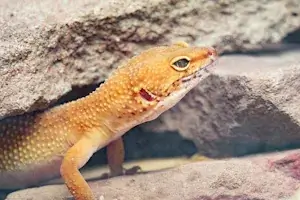EiIntroduction: Why Keep Geckos as Pets?
Geckos are fascinating and low-maintenance reptiles, making them suitable for both beginners and experienced terrarium enthusiasts. With their exotic appearance, intriguing behaviors, and wide variety of species, they offer an engaging hobby. Whether it’s a leopard gecko, tokay gecko, or crested gecko, this article will provide you with everything you need to know about keeping geckos in an appropriate environment.
Choosing the Right Gecko Species
Popular Gecko Species and Their Traits
Leopard Gecko (Eublepharis macularius):
- Origin: Arid regions of Asia.
- Size: 20–25 cm.
- Traits: Calm, nocturnal, and low-maintenance.
Tokay Gecko (Gekko gecko):
- Origin: Southeast Asia.
- Size: Up to 35 cm.
- Traits: Vibrantly colored, active, but more challenging to care for.
Crested Gecko (Correlophus ciliatus):
- Origin: New Caledonia.
- Size: 15–25 cm.
- Traits: Arboreal, easy to care for, does not require UV lighting.
Day Gecko (Phelsuma spp.):
- Origin: Madagascar and nearby islands.
- Traits: Diurnal, brightly colored, ideal for tropical terrariums.
Which Species is Right for You?
Beginners should start with low-maintenance species like the leopard gecko. Advanced keepers can take on more demanding species like the tokay gecko.
Setting Up the Perfect Gecko Terrarium
Terrarium Size and Type
- Leopard Gecko: Minimum size 80 x 40 x 40 cm for a pair.
- Crested Gecko: 60 x 45 x 60 cm (height is crucial due to arboreal habits).
- Day Gecko: 100 x 50 x 80 cm for single or pair housing.
Terrarium Setup
- Substrate:
- For desert geckos: Sand-clay mix.
- For tropical geckos: Coconut fiber or bark mulch.
- Hiding Spots: Provide caves, cork tubes, stones, and plants for security.
- Climbing Structures: Essential for arboreal species like crested and day geckos.
- Plants: Use real or artificial plants suited to the gecko species.
Lighting and Temperature
- UV Lighting: Crucial for most species except crested geckos.
- Daytime Temperature: 24–30°C, with a nighttime drop to 18–22°C.
- Heat Sources: Use heat lamps or mats.
Humidity Levels
- Desert Geckos: 30–40%.
- Tropical Geckos: 60–80%, with regular misting required.
Feeding Geckos: What Do They Eat?
Primary Diet
Geckos are primarily insectivores. Common feeder insects include:
- Crickets, locusts, cockroaches, grasshoppers.
Tropical species like crested geckos also eat fruit puree or specialized gecko diets.
Supplements and Vitamins
- Calcium and Vitamins: Essential to prevent deficiencies.
- Dusting Feeders: Coat insects with calcium and vitamin supplements before feeding.
Feeding Schedule
- Juveniles: Feed daily.
- Adults: Feed every 2–3 days.
Water Access
Provide a shallow water dish at all times. Tropical geckos may also drink water droplets from plants.
Care and Health
Terrarium Maintenance
- Daily Cleaning: Remove waste and leftover food.
- Deep Cleaning: Fully clean the terrarium every 4–6 weeks.
Health Checks
- Signs of Illness: Loss of appetite, weight loss, skin issues.
- Common Problems: Parasites or metabolic disorders from vitamin deficiencies.
- Vet Visits: Consult a reptile veterinarian if any abnormalities occur.
Gecko Behavior and Handling
Observation Over Handling
Geckos are best observed rather than handled frequently.
- Minimize Stress: Only handle when necessary (e.g., during cleaning).
- Tail Drop: Geckos may drop their tails if they feel threatened.
Understanding Behaviors
- Leopard Geckos: Active at dusk and nighttime.
- Day Geckos: Diurnal, often seen climbing glass surfaces.
- Crested Geckos: Usually found in the upper areas of the terrarium.
Breeding Geckos: For Advanced Keepers
Reproduction in Terrariums
- Gender Identification: Males have visible hemipenal bulges and femoral pores.
- Mating Season: Typically occurs during the active months (spring/summer).
Egg Laying and Incubation
- Geckos usually lay 1–2 eggs per clutch.
- Incubate eggs at 26–30°C with 60–80% humidity.
Raising Hatchlings
- Use a separate terrarium for hatchlings.
- Feed them small insects like fruit flies.
Legal and Cost Considerations
Legal Requirements
- Some species, like day geckos, are protected and may require permits.
- Check for registration and documentation obligations.
Cost Overview
- Purchase Price: €30–€200 per gecko, depending on the species.
- Terrarium Setup: €150–€500.
- Ongoing Costs: Food and electricity for heating and lighting.
Conclusion: Geckos – Fascinating Reptiles for Every Home
Keeping geckos is a rewarding experience for reptile enthusiasts. With proper preparation and care, you can create a habitat where your geckos thrive. Whether it’s a leopard gecko, crested gecko, or day gecko, these fascinating creatures are sure to enrich your terrarium hobby.

